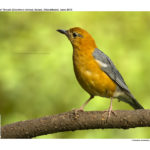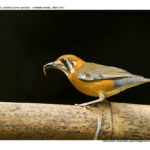Orange-headed Thrush
Orange-headed Thrush Zoothera citrina
Etymology :
- Zoothera : Greek word zoon animal; theras–hunter
- Citrina : Latin word for Citrine colour
Zoothera citrina cyanotus
- Zoothera : Greek word zoon animal; theras–hunter
- Citrina : Latin word for Citrine colour
- Cyanotus : Greek word kuanosdark-blue; otis-eared.
Vernacular Names: Hindi: Safedgaalakasturi, Sans: Shwet-kanthbhukasturika, H.P.: Malagir, Pun: Santrikasturi, Ben: Dama, Cachar: Daokat-gajauiaba, Guj: Malagirkasturo, Narangikasturo, Mar: Kshitikastur, NarangiDokyachaKastur, Ta: Mampalachittu, Mal: Kozhikili, Koori kannankattupulleh Kan: Shwetakanta thrush, Nicobar: Chook-chyong
Distribution in India: Resident of North East, Central and West India, summer visitor to Himalayas and winter visitor to EastIndia. Sub species Z.c cyanotus is resident of Peninsular India.
Description: Size of 20-21 cm. The male nominate race is dull pale orange with vaguely mottled matt and glossy grey mantle to wings and tail. The median wing-coverts are white, lower belly to undertail-coverts are white. The bill is blackish and paler base with dull legs. Thefemale is similar, but slaty-grey of mantle and back is replaced by dull matt and glossy greenish-brown and the wings and tail are also brown. The sub-species in peninsular India Z.c.cyanotus hasa white ear covert and vertical black stripes running through the ear coverts.
Habitat: It is found in understorey of moist deciduous forest and evergreen forest, mixed secondary and bamboo thickets, plantations and shady village groves, often or mainly near running water and in lower-elevation ravines. It is found from 900 to 2500 m.
Food habits : It eats Insects, earthworms, leeches, slugs, snails, berries, fruit and grass seed. It rummages quietly for food among leaf litter under shrubbery and dense undergrowth, mainly gleaning from substrate, actively tossing leaves aside; also probing in earth and in mossy crevices between stones. It eats fruit from high in trees.
Breeding habits: They breed in Apr–Jun in Himalayas, May–Sept elsewhere in India. The nest is a shallow thick cup of stems, soft bark, roots and green moss mixed with mud, lined with moss, fern roots and fibres, placed up in bush, bamboo or tree at forest edge. The nest bottom has long dangling strands of material. They lay a clutch of 3–4 eggs. The incubation period is 13–14 days. The nestling period is 12 days. The nest is parasitized by Jacobin Cuckoo.

